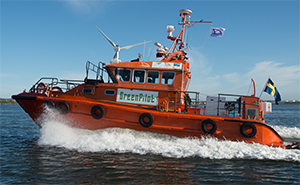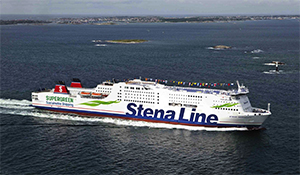There are a number of compelling reasons why methanol should be adopted for use as a marine fuel, according to its advocates. But the most compelling are the mandates put in place through the International Maritime Organization (IMO), which is putting increasing pressure on vessel operators to cut nitrogen oxide and sulfur dioxide emissions.
That pressure has resulted in some impressive implementations of methanol as a primary or alternative fuel. The ultimate methanol poster child is Stena Line’s Stena Germanica, a 787-foot ferry providing service between Gothenburg, Sweden, and Kiel, Germany. Prior to its conversion to methanol, the vessel was known as Stena Hollandica and sailed an England-to-Holland route. British Columbia-based Waterfront Shipping, a subsidiary of Methanex Corp., a global giant in methanol production, has built seven 50,000-deadweight-ton tankers powered by two-stroke, dual-fuel engines capable of running on methanol as well as fuel oil, marine diesel oil or gas oil. And in Sweden, a pilot boat has been converted to run on methanol in yet another demonstration program. So far, the tide has not reached the United States, but that could change.
Advocates see methanol as a clean and transitional fuel that could serve well into the future while also potentially leading to the use of other fuels such as ethanol. The IMO’s implementation of sulfur emission control areas (SECAs) in North America and the Caribbean, as well as the North Sea and Baltic Sea in Europe, provided a solid argument in favor of methanol. If that wasn’t enough, the IMO followed up with a directive that nitrogen oxide (NOx) emissions also be reduced, at least for newly constructed vessels in North America and the Caribbean. Those mandates have provided a powerful impetus to consider alternative fuels, since compliance otherwise is dependent on obtaining much more expensive low-sulfur fuel or installing either stack scrubbers or catalytic converters.
Methanol, once derived primarily from small-scale distillation of wood, has very low emissions when burned. It is now plentiful because modern methods allow its manufacture from fossil feedstocks, particularly natural gas. Because it is a liquid across a wide range of temperatures, it is relatively easy to handle — especially compared to other alternative fuels such as liquefied natural gas (LNG). The U.S. consumes about 6.5 million tons of methanol annually, primarily in the chemical industry, and still imports a substantial portion of that figure.
“We will top that total with new production capacity from a plant in Beaumont, Texas. In fact, by the end of 2017, the U.S. is expected to be a next exporter of methanol,” according to Gregory Dolan, CEO of the Washington, D.C.-based Methanol Institute. Today, according to Dolan, global consumption is about 75 million metric tons and more than a third of that — some 29 million tons — is shipped across the oceans. Methanol is currently the most widely shipped chemical commodity, he said.
“Methanol is a great fuel for any internal combustion engine as well as for gas turbines or even for firing a boiler,” said Ted Mason, founder and managing partner of Eastwind Power Partners Ltd., a developer of independent power projects and a consulting firm in the energy industry. “The primary factor standing in the way of wider adoption is economic because there are competing fuels that cost less per million BTUs.” But methanol’s clean-burn features are compelling, he said.
“Now it is a question of your long-term view, whether or not you think oil prices are coming back up,” he said. “Here in the U.S. and in Canada, where we have an abundance of natural gas that’s expected to last for a long time, we are well situated regarding methanol because that is its primary feedstock, which means it could become more competitive and it should have less price volatility.”
With oil at $50 per barrel, methanol is a harder sell as a fuel, Mason said. It also requires roughly twice the volume of storage to deliver the same heat energy as liquid petroleum. “This is similar to the challenge with LNG,” he said. However, when oil is in the $65-to-$70 range, he believes that investing in the handling and tankage equipment for methanol could make sense, especially if it aligns with IMO compliance needs.
 |
|
Pilot Boat 729 has been converted to operate on methanol for the GreenPilot project in Sweden. The project, led by the Swedish Maritime Technology Forum, aims to demonstrate the feasibility of such conversions for smaller vessels and document the emissions reductions that can be achieved. |
|
Courtesy ScandiNAOS |
Because methanol is already a big industry, the infrastructure exists at a scale that could support marine fuel requirements, Mason said. Citing the example of Methanex and its tankers, he said it was a simple choice. The need to meet IMO requirements and the ability to tap into the company’s massive methanol distribution system provided a winning combination.
In the case of Stena Line, one of the biggest ferry operators in the world, Mason said he is convinced the company did a careful analysis of future fuel choices when converting Stena Germanica. “They must have looked at LNG and low-sulfur diesel before they chose methanol,” he said. What they saw would have been greater complexity and greater space requirements for LNG. Low or ultra-low sulfur diesel also doesn’t necessarily get an operator through all of the IMO hoops. Methanol, on the other hand, can be bunkered in double-hulled vessels. Storing it shipboard has few penalties, and landside equipment requirements are modest. Even its environmental risks are minimal compared to most fuels. “It is volatile, so even a spill will disappear rapidly without much intervention,” Mason said.
In the United States and Canada, adoption of methanol as a marine fuel is more of an awareness issue, according to Dolan. In Europe, the European Commission has been supportive of experiments like Stena Germanica, and in the case of Waterfront Shipping, the parent company is a methanol producer making an investment in its own industry. “Now, though, we are seeing more interest here, and where the opportunities are is in moving from the cargo hold to the ship bunkers,” he said.
For example, some of his organization’s members have been talking to barge operators that already are involved in transporting methanol from the Gulf Coast up the Mississippi River. For them, moving to methanol as a marine fuel would be picking the low-hanging fruit, using the model of Waterfront Shipping and its tanker fleet to power the transportation of methanol in the region.
Meanwhile, regulatory pressure will likely continue. “I don’t see shipping companies making much investment in scrubbers,” Dolan said, adding that most shippers seem to be assuming that there will be plenty of marine gas oil or low-sulfur fuel available, or that the regulations won’t really go into effect. As a result, there could be a price spike for those fuels when the companies are required to meet emissions guidelines, he said.
Part of the focus of the Methanol Institute is on getting more methanol-fueled vessels into the water, representing more types of vessels, Dolan said. The institute is also working on standards. “We were involved in London on IMO standards for low-flashpoint fuels, and we are looking to expand on the work involved in creating the LNG standard to now allow fuel cells, ethanol and methanol into marine service,” he said.
In addition, the institute is working closely with classification societies on the vessels it is supporting and working with Lloyd’s Register on related projects. In other words, the organization is “trying to set the stage for fair consideration of methanol as an option for meeting IMO 2020 requirements,” Dolan said. That’s when a new global cap will force ship operators to move past the 3.5 percent sulfur fuel currently allowed and adopt marine fuels with a sulfur content of no more than 0.5 percent.
Dolan believes that methanol has an advantage because of the IMO’s nitrogen oxide requirement. Taking sulfur out of fuel doesn’t help with the NOx mandate, and methanol is one of the best ways to achieve that. “Beyond 2020, the next focus of the IMO will be on greenhouse gas emissions, and we consider methanol to be ‘future proof’ in that regard because it has low emissions and because the feedstocks are either low-carbon sources or renewable,” he said.
Lt. Amy Midgett, a spokeswoman for the U.S. Coast Guard, said the service “has not seen any serious interest or proposals yet” for U.S.-flag vessels to use methanol as a fuel. However, she added, the Coast Guard is aware that the option is gaining some traction in Europe.
“Current work at the IMO on the IGF Code includes development of requirements to specifically address methyl and ethyl alcohol (methanol and ethanol) as fuel within the code,” she said. “Methanol is considered by some to be easier to handle than LNG since it is not a cryogenic liquid, however there are issues with toxicity that need to be addressed.”

